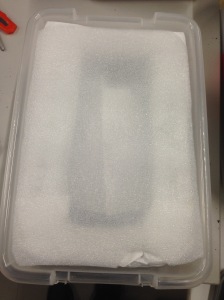It had never crossed my mind, until recently, that all the wonderful artefacts you see in museums and galleries need some sort of ‘holiday home’ where they can rest in safety when they take a break from being on display.
Not having owned an array of precious art works and therefore never having had a need to store them off season, I would have assumed, had I contemplated the issue, that galleries had enormous storage rooms where, in their down time, the treasures sat on shelves behind glass, a bit like a mirror image of their upstairs life, on ‘display’ but seen by no-one, until they’re let out again to be admired.
Where do you go to, my lovelies, when you’re out of favour?
But following a further stint volunteering at our local galley/art museum, MAMA, I’ve now discovered where they’re all stored. And I’ve been lucky enough to assist there, wearing white cotton gloves as I work in a locked room behind another locked room, where no sunlight ever penetrates, sealing their fate.
Yes, I’ve been permitted to enter the hallowed, temperature controlled bowels of MAMA to
#46 Learn how to ‘Nest’
It turns out that each individual item needs its own special box into which to snuggle down, cosseted in folds of exclusive wrapping material and buried in foam that’s been carefully sculpted to match its shape such that when it’s all packaged up, even an earthquake couldn’t damage it.
This is called ‘nesting’ and if you loved messing about with scissors, glue guns, paper, box cutters and firm craft foam when you were young, have I got the job for you.
So…
We start with the item/s needing a holiday:
Metal disc (and stand) with $1 coin for perspective, waiting for their nest
Cut, sculpt and paste very special black foam, known only to the cognoscenti, into the shapes you need to closely fit the items:
Then cover this foam in a protective, spun bonded material known as Tyvek ® and attach it using your glue gun.
Tacking pins can help with this sometimes tricky procedure:
If your shapes and sculpting, and wrapping and glueing have all been calculated correctly, the covered foam will look like this:
And your precious items will fit like a glove:
All that’s needed is to slip this into the plastic box that you’ve previously chosen for its snug fit, place a layer of protection on top so it forms a seal under the lid, like this…
And voila!
Nest in peace safely, my little treasure…
Once nesting small items has been mastered, you can move onto much larger ones.
…scarier, too
The principles are the same, though.
From this…
via this…
to this…
then this…
To final, sealed, resting place…
There is a downside to learning how to nest, though.
I discovered this by accident after reading a recent newspaper article, with photos, about the return to Egypt of plundered sarcophagus covers dating back to the time of the Pharaohs.
Rather than focussing on the amazing, plaster-coated wooden sarcophagus decorated with hieroglyphics and brilliant illustrations, and rather than marvelling that something dating back to 3000 BC was still in existence and intact, I found myself studying the packing, the foam and the Tyvek ® very, very carefully and thinking, ‘I could have nested that. Easy as…’

















